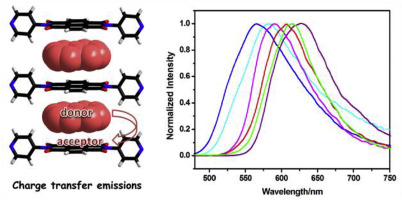Dyes and Pigments ( IF 4.1 ) Pub Date : 2017-09-25 , DOI: 10.1016/j.dyepig.2017.09.058
Jian-Jun Liu , Teng Liu , Shu-Biao Xia , Chi-Xian He , Fei-Xiang Cheng , Mei-Jin Lin , Chang-Cang Huang

|
Naphthalene diimides are attracting considerable interest because of their tunable luminescent properties, which are generally achieved by the incorporation of electron-donating moieties into naphthalene diimides core to form donor-acceptor compounds through covalent bond. However, this method is an elaborate strategy because the separation of byproduct is tedious. Here we report that the luminescent properties of naphthalene diimides can be finely modulated by supramolecular cocrystal formation. Through the donor-acceptor interactions between the electron-deficient N,N′-di-(4-pyridyl)-1,4,5,8-naphthalene diimide (DPNDI) molecules and electron-rich naphthalene derivatives (guest), a series of cocrystal complexes are successfully fabricated. These cocrystal complexes show guest-dependent color-tunable emissions, which originate from the excited state charge transfer interactions between the DPNDI and naphthalene derivatives in the solid state. The present study anticipates providing a new method for the design of various new types of organic luminescent materials.
中文翻译:

萘二酰亚胺与萘衍生物的共晶体:调节发光性能的简便方法
萘二酰亚胺由于其可调节的发光特性而引起了极大的兴趣,这通常是通过将给电子部分掺入萘二酰亚胺核中以通过共价键形成供体-受体化合物来实现的。但是,由于副产物的分离很繁琐,因此该方法是一种精心设计的策略。在这里我们报告说,可以通过超分子共晶体的形成来精细地调节萘二酰亚胺的发光特性。通过缺电子的N,N之间的供体-受体相互作用′-二-(4-吡啶基)-1,4,5,8-萘二酰亚胺(DPNDI)分子和富含电子的萘衍生物(客体),成功制备了一系列共晶配合物。这些共晶体配合物显示出依赖于客体的颜色可调发射,其源于固态中DPNDI和萘衍生物之间的激发态电荷转移相互作用。本研究预期为设计各种新型有机发光材料提供一种新方法。































 京公网安备 11010802027423号
京公网安备 11010802027423号